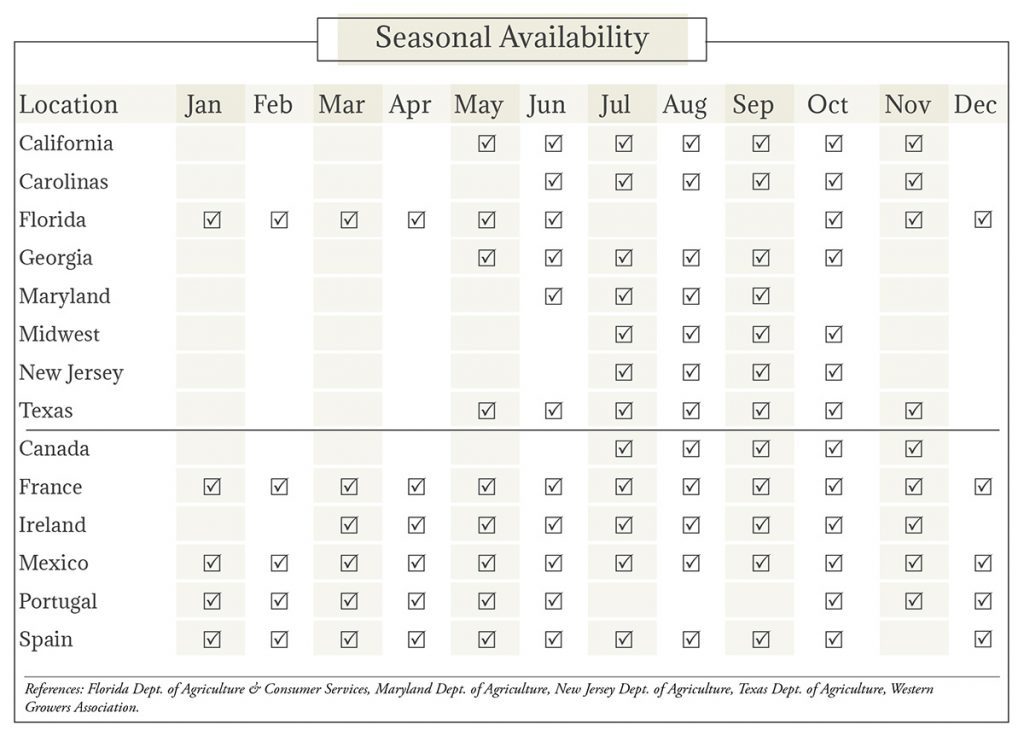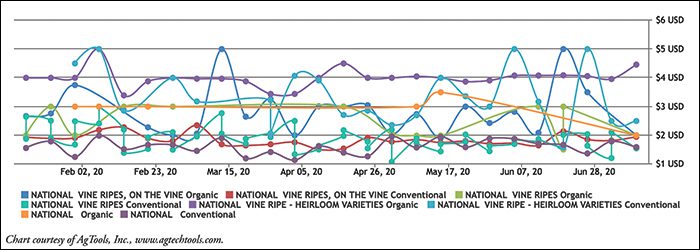Tomato Market Summary

Image: Ewa Studio/Shutterstock.com
Tomato Market Overview
The tomato is a warm-season crop belonging to the nightshade family. Color patterns include red, white, purple, yellow, orange, brown, mottled, or striped. Originating in South America, tomatoes were taken to parts of Europe by Spanish conquistadors in the sixteenth century. Others believe the fruit might have been introduced to Europe as early as the fifteenth century, making its way into France, Italy, and North Africa. Botanically speaking, the tomato is a fruit. In 1893, however, the U.S. Supreme Court ruled it would be treated as a vegetable due to a tariff dispute. In the United States, the tomato is the second most produced “vegetable” after potatoes.Tomatoes for processing are typically harvested by machine, while those for fresh consumption are picked by hand, in fields and greenhouses. For more information about greenhouse tomatoes, see our separate Greenhouse section. Although China grows the most tomatoes, the United States is second, with Florida and California leading domestic production. Mexico comprises nearly three-quarters of the U.S. import market.

Types & Varieties of Tomatoes
Tomatoes usually fall into one of two types: determinate and indeterminate. Determinate varieties grow to a certain height and produce fruit for one cycle. Indeterminate varieties require staking or caging and grow throughout the season. Commercially, determinate varieties are more widely grown than indeterminate as the latter are typically more popular for home gardens. Hundreds of varieties exist as either heirlooms or hybrids. Heirloom seeds can be saved for the next season and are often used for generations. Hybrid tomatoes are a combination of two varieties, and because seeds may produce something different from parent fruit, they are generally not saved. Tomatoes also have several different shapes: globe, cherry, beefsteak, and plum/pear/grape. For years, the most common tomato found at grocery stores was the globe—smooth, round, and medium in size—though others continue to climb in popularity and sales. Cherry tomatoes, also smooth and round, range in size from one to two inches in diameter. Beefsteak tomatoes are large, wide, and somewhat flat-looking. Plum or Roma, as well as pear and grape varieties, have smooth skin and are shaped as their names imply. Tomatoes as categorized by the USDA are greenhouse, fresh, cherry, or on-the-vine.The Cultivation of Tomatoes
The ideal soil type for growing tomatoes is slightly acidic, well-drained, and loamy. Tomatoes should not be planted on land where peppers, eggplant, or potatoes have been grown in the last three years to avoid nematode infestations or residual herbicides. Depending on the area, fumigation may be necessary to control pests, weeds, and some diseases. Proper staking/caging and irrigation are important for good yields.
Pests & Diseases Affecting Tomatoes
Aphids feed on leaves making them curl and become distorted. Loopers also feed on foliage, creating ragged holes. White flies feed on the underside of leaves turning them black. Tomato russet mites, which cause bronzing and defoliation, are very difficult to detect. Other pests to look out for include flea beetles, cutworms, leafminers, stink bugs, and the aforementioned nematodes in soil. Tomato pinworms, tomato fruitworms, and vegetable weevils also pose a threat. Botrytis grey mold turns leaves brown with grey mold noticeable on stems and leaves. Fusarium wilt causes foliage to yellow and wilt. Blossom end rot will appear as dark, flattened, or sunken areas on the blossom end of the fruit and can result from insufficient calcium levels. Blight (both early and late), alternaria, big bud, buckeye rot, white mold, canker, and powdery mildew can cause problems as well.Storage & Packaging of Tomatoes
Mature green tomatoes are typically harvested by hand and sorted by size, graded, and placed in temporary cold storage. Optimum temperatures for mature green tomatoes are 55 to 60°F; for light red (categorized as USDA Color Stage 5, described as “Light red: 60% to 90% of the surface is not green; in the aggregate, shows pinkish-red or red”) in the 50 to 55°F range; and for firm-ripe (USDA Color Stage 6, “Red: More than 90% of the surface is not green; in the aggregate, shows red color”), 44 to 50°F for 3 to 5 days is optimal. Tomatoes held at 50°F for longer than 2 weeks or at 41°F for longer than 6 to 8 days are vulnerable to chilling injury. Optimum relative humidity is 90 to 95% but extended periods of higher humidity may encourage the growth of surface mold and/or other concerns due to excess condensation. Ethylene is typically applied to mature green tomatoes for uniform ripening. Because ripening tomatoes produce ethylene themselves at a moderate rate, storage and/or shipping with ethylene-sensitive commodities should be avoided. References: Texas A&M Agri-Life Extension, UC Davis Postharvest Technology Center, University of California Agriculture & Natural Resources, University of California Cooperative Extension, University of Tennessee, USDA.Grades & Good Arrival of Tomatoes
Generally speaking, the percentage of defects shown on a timely government inspection certificate should not exceed the percentage of allowable defects, provided: (1) transportation conditions were normal; (2) the USDA or CFIA inspection was timely; and (3) the entire lot was inspected.| FRESH TOMATOES & CHERRY U.S. Grade Standards | Days Since Shipment | % of Defects Allowed | Optimum Transit Temp. (°F) |
| 15-[10 SDA] [10 other] [5 VSD]-5 | 5 4 3 2 1 | 20-[15 SDA] [15 other] [8 VSD]-8 19-[14 SDA] [14 other] [8 VSD]-8 18-[13 SDA] [13 other] [7 VSD]-7 17-[11 SDA] [11 other] [6 VSD]-6 15-[10 SDA] [10 other] [5 VSD]-5 | 46-50° (pink) 55-70° (green) |
| TOMATOES-ON-THE-VINE U.S. Grade Standards | Days Since Shipment | % of Defects Allowed | |
| 10-5-2 | 5 4 3 2 1 | 15-8-4 14-8-4 13-7-3 11-6-2 10-5-2 |
Inspector's Insights for Tomatoes
- Tomatoes marked as “5x6” (five rows of six tomatoes in two layers within a box) have a minimum diameter of 2.78 inches and no maximum; “Extra Large” tomatoes also have a minimum diameter of 2.75 inches but no maximum
- ‘Catfaces’ are misshapen or puckered blossom ends and involve the imperfect development of certain areas which, at maturity, are represented by an irregular, leathery scar (score as damage when the scars are rough or deep, channels are very deep or wide, or extend into a locule, or a fairly smooth catface aggregating a circle more than half an inch in diameter)
- Moldy stems or calyxes are considered objectionable when materially detracting from appearance and shall be scored as a defect, not as decay; slight amounts of mold affecting the tips of the stem or edges of the calyx shall be disregarded.
Tomato Retail Pricing: Conventional & Organic

Varietal Showcase: Roma TomatoesRoma tomatoes, also known as plum tomatoes, are one of the most popular tomato varieties due to their firm texture and robust flavor. First cultivated in Italy, Roma tomatoes were bred to have thick skin, denser flesh, less juice, and high levels of both acid and sugar for a sweet yet tangy taste.
Because Romas maintain their flavor exceptionally well, they’re favored for cooking and processing. They are ideal for tomato sauces and pastes, and just as popular in salads, salsas, and soups.
Romas are smaller than round tomatoes and have an oval or oblong shape. They grow best in warm, sunny climates with U.S. field production concentrated in California and Florida, although they are grown in greenhouses across the nation and in Canada. Mexico leads North American production for both field-grown and controlled environments, with the fruit available year-round.
|
Varietal Showcase: Round TomatoesRound or globe tomatoes are one of the most commonly cultivated and consumed tomato varieties around the world. They are characterized by their uniform spherical shape, smooth skin, vibrant red coloring, and firm, juicy flesh. Size ranges from medium to large and include beefsteak tomatoes.
Highly versatile, round tomatoes are have a mild flavor of balanced sweetness and acidity. They are perfect for serving raw (sliced or chopped) or for use in soups, stews, and sauces, or for juice or purees.
Although greenhouse production continues to expand worldwide, particularly for premium and specialty tomatoes, most rounds are still grown in open fields. This is especially true for large-scale distribution due to their durability and shelf life. Florida and California are major producers in the United States.
|

